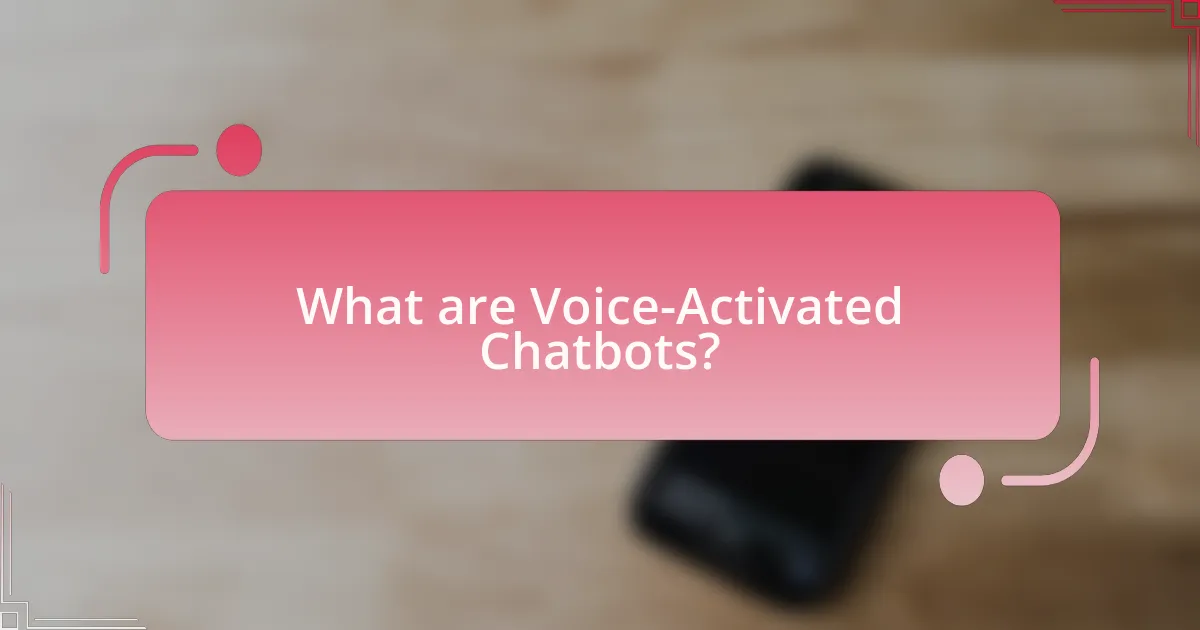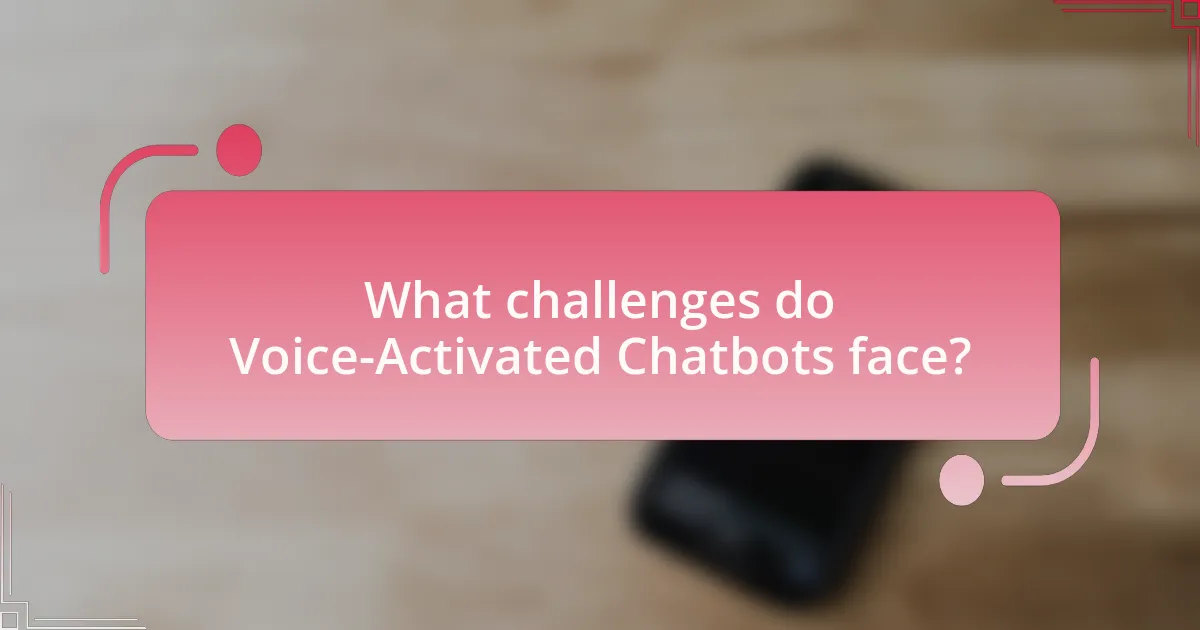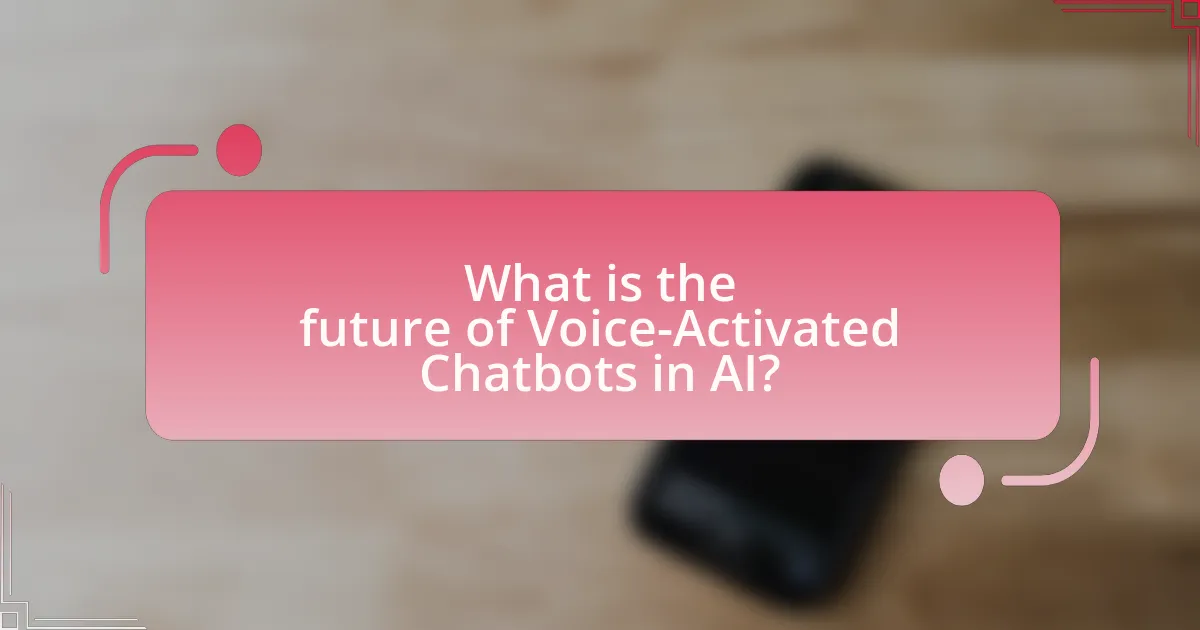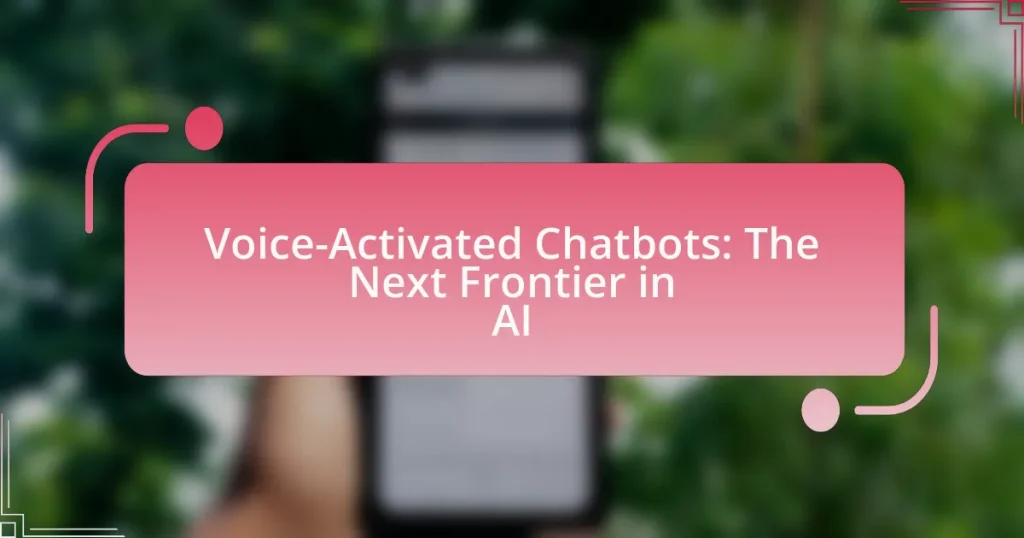Voice-activated chatbots are advanced artificial intelligence systems that utilize voice recognition technology to facilitate spoken interactions with users. This article explores their functionality, which combines automatic speech recognition (ASR) and natural language processing (NLP) to interpret and respond to voice commands. Key features such as context awareness and integration with various platforms enhance user experience, while applications span customer service, healthcare, and smart home technology. The article also addresses challenges like speech recognition accuracy and privacy concerns, alongside advancements in AI that promise to improve these chatbots’ capabilities and user engagement in the future.

What are Voice-Activated Chatbots?
Voice-activated chatbots are artificial intelligence systems that utilize voice recognition technology to interact with users through spoken language. These chatbots process voice commands and respond verbally, enabling hands-free communication and enhancing user experience. According to a report by Statista, the global voice recognition market is projected to reach $27.16 billion by 2026, indicating a significant growth in the adoption of voice-activated technologies.
How do Voice-Activated Chatbots function?
Voice-activated chatbots function by utilizing automatic speech recognition (ASR) to convert spoken language into text, followed by natural language processing (NLP) to understand and generate appropriate responses. ASR systems analyze audio input, breaking it down into phonemes and words, which are then processed by NLP algorithms to interpret user intent and context. For instance, Google Assistant employs advanced machine learning models to enhance its understanding of diverse accents and speech patterns, demonstrating the effectiveness of these technologies in real-world applications.
What technologies enable Voice-Activated Chatbots?
Voice-activated chatbots are enabled by several key technologies, including Automatic Speech Recognition (ASR), Natural Language Processing (NLP), and Text-to-Speech (TTS) systems. ASR converts spoken language into text, allowing the chatbot to understand user input. NLP processes this text to interpret the intent and context, enabling meaningful responses. TTS then converts the chatbot’s text responses back into spoken language, facilitating a natural conversation flow. These technologies work together to create an interactive and user-friendly experience, as evidenced by their widespread use in applications like virtual assistants and customer service bots.
How do natural language processing and speech recognition work together in these chatbots?
Natural language processing (NLP) and speech recognition work together in chatbots by enabling the conversion of spoken language into text and then interpreting that text to generate appropriate responses. Speech recognition technology captures the user’s voice input and translates it into a textual format, which is then processed by NLP algorithms to understand the intent and context of the user’s query. This integration allows chatbots to engage in natural, conversational interactions, enhancing user experience and accessibility. For instance, advancements in NLP, such as deep learning models, improve the accuracy of intent recognition, while sophisticated speech recognition systems, like those developed by Google and IBM, ensure high-quality transcription of spoken language, facilitating seamless communication between users and chatbots.
What are the key features of Voice-Activated Chatbots?
Voice-activated chatbots possess several key features that enhance user interaction and experience. These features include natural language processing (NLP) capabilities, enabling the chatbot to understand and respond to spoken language effectively. Additionally, voice recognition technology allows the chatbot to accurately identify and process user commands, facilitating seamless communication. Another important feature is context awareness, which enables the chatbot to maintain the context of a conversation, providing relevant responses based on previous interactions. Furthermore, integration with various platforms and devices enhances accessibility, allowing users to interact with chatbots across multiple channels. These features collectively improve user engagement and satisfaction, making voice-activated chatbots a significant advancement in AI technology.
How do Voice-Activated Chatbots enhance user experience?
Voice-activated chatbots enhance user experience by providing hands-free, efficient, and intuitive interactions. These chatbots allow users to engage in conversations using natural language, which simplifies the process of obtaining information or completing tasks. According to a study by PwC, 71% of consumers prefer voice-activated technology for its convenience, indicating a strong preference for this mode of interaction. Additionally, voice-activated chatbots can process requests faster than traditional text-based interfaces, reducing wait times and improving overall satisfaction. This efficiency is supported by advancements in natural language processing, which enable chatbots to understand and respond to user queries accurately and contextually.
What differentiates Voice-Activated Chatbots from traditional text-based chatbots?
Voice-Activated Chatbots differ from traditional text-based chatbots primarily in their mode of interaction; the former utilizes voice recognition technology to process spoken language, while the latter relies on text input. Voice-Activated Chatbots can interpret and respond to user queries through natural speech, enabling a more conversational and intuitive user experience. This technology often incorporates advanced features such as speech-to-text conversion and natural language understanding, allowing for real-time dialogue. In contrast, traditional text-based chatbots require users to type their questions, which can limit the speed and fluidity of interactions. Studies indicate that voice interactions can enhance user engagement and satisfaction, as they mimic human conversation more closely than text-based exchanges.
What are the potential applications of Voice-Activated Chatbots?
Voice-activated chatbots have numerous potential applications across various sectors. In customer service, they can handle inquiries and provide support, significantly reducing wait times and improving user satisfaction. In healthcare, these chatbots can assist patients by scheduling appointments, providing medication reminders, and answering health-related questions, thereby enhancing patient engagement and adherence to treatment plans. In the education sector, voice-activated chatbots can serve as virtual tutors, offering personalized learning experiences and answering student queries in real-time. Additionally, in smart home technology, these chatbots can control devices, manage home security, and facilitate seamless interaction with users, contributing to a more integrated living environment. The versatility of voice-activated chatbots makes them valuable tools in enhancing efficiency and user experience across these diverse applications.
In which industries are Voice-Activated Chatbots most commonly used?
Voice-Activated Chatbots are most commonly used in the customer service, healthcare, retail, and automotive industries. In customer service, companies utilize these chatbots to enhance user experience by providing instant responses to inquiries. In healthcare, they assist patients with appointment scheduling and medical information. Retailers employ voice-activated chatbots for facilitating online shopping and customer support. The automotive industry integrates these chatbots for hands-free navigation and vehicle control. These applications demonstrate the versatility and growing adoption of voice-activated chatbots across various sectors.
How can businesses leverage Voice-Activated Chatbots for customer service?
Businesses can leverage Voice-Activated Chatbots for customer service by integrating them into their communication channels to provide instant, 24/7 assistance. These chatbots can handle a variety of customer inquiries, such as FAQs, order tracking, and troubleshooting, thereby reducing wait times and improving customer satisfaction. According to a study by Juniper Research, voice-based interactions are expected to account for 30% of all customer service interactions by 2025, highlighting the growing importance of this technology. By utilizing natural language processing, these chatbots can understand and respond to customer queries more effectively, leading to enhanced user experiences and operational efficiency.

What challenges do Voice-Activated Chatbots face?
Voice-activated chatbots face several challenges, including speech recognition accuracy, natural language understanding, and user privacy concerns. Speech recognition accuracy can be hindered by background noise, accents, and variations in speech patterns, leading to misunderstandings. Natural language understanding is complicated by the need for chatbots to interpret context and intent, which can vary significantly among users. Additionally, user privacy concerns arise from the collection and storage of voice data, prompting users to be wary of how their information is used. These challenges impact the effectiveness and user acceptance of voice-activated chatbots in various applications.
What are the limitations of current Voice-Activated Chatbot technology?
Current voice-activated chatbot technology has several limitations, including difficulties in understanding diverse accents and dialects, which can lead to miscommunication. Additionally, these chatbots often struggle with context retention, making it challenging to maintain coherent conversations over multiple exchanges. Furthermore, they may have limited capabilities in handling complex queries or providing nuanced responses, as they primarily rely on pre-defined scripts and machine learning models that may not cover all scenarios. Research indicates that around 30% of users experience frustration due to these limitations, highlighting the need for further advancements in natural language processing and machine learning to enhance user experience.
How do issues with speech recognition impact user interaction?
Issues with speech recognition significantly hinder user interaction by causing misunderstandings and frustration. When speech recognition systems fail to accurately interpret user commands, it leads to incorrect responses or actions, diminishing user trust and satisfaction. For instance, a study by the Stanford University researchers found that errors in speech recognition can result in a 30% increase in user task completion time, indicating that inefficiencies directly affect user experience. Furthermore, persistent inaccuracies can discourage users from engaging with voice-activated chatbots, ultimately limiting their effectiveness and adoption in various applications.
What privacy concerns are associated with Voice-Activated Chatbots?
Voice-activated chatbots raise significant privacy concerns primarily related to data collection and user surveillance. These chatbots often record and store voice interactions, which can lead to unauthorized access to sensitive personal information. For instance, a study by the Electronic Frontier Foundation highlights that many voice-activated devices continuously listen for activation phrases, potentially capturing private conversations without user consent. Furthermore, data breaches involving voice data can expose users to identity theft and other privacy violations, as evidenced by incidents where companies have mishandled or inadequately secured user data.
How can these challenges be addressed?
To address the challenges faced by voice-activated chatbots, developers can implement advanced natural language processing algorithms and machine learning techniques. These technologies enhance the chatbot’s ability to understand context, manage diverse accents, and improve response accuracy. For instance, integrating deep learning models, such as recurrent neural networks, has been shown to significantly increase the effectiveness of speech recognition systems, as evidenced by a study published in the Journal of Artificial Intelligence Research, which demonstrated a 20% improvement in understanding varied speech patterns. Additionally, continuous user feedback can be utilized to refine the chatbot’s performance, ensuring it evolves with user needs and preferences.
What advancements are being made to improve Voice-Activated Chatbots?
Advancements in improving voice-activated chatbots include enhanced natural language processing (NLP) capabilities, improved speech recognition accuracy, and the integration of machine learning algorithms. These developments enable chatbots to understand context better, recognize diverse accents, and respond more accurately to user queries. For instance, recent studies show that using transformer models, such as BERT and GPT, significantly boosts the understanding of user intent, leading to more relevant responses. Additionally, advancements in voice synthesis technology have made chatbot voices sound more natural and human-like, enhancing user experience and engagement.
How can businesses ensure user privacy while using Voice-Activated Chatbots?
Businesses can ensure user privacy while using voice-activated chatbots by implementing robust data encryption and anonymization techniques. Data encryption protects user information during transmission and storage, making it inaccessible to unauthorized parties. Anonymization removes personally identifiable information from user data, ensuring that interactions cannot be traced back to individual users. According to a report by the International Association of Privacy Professionals, 79% of consumers express concern about their privacy when using AI technologies, highlighting the importance of these measures. Additionally, businesses should comply with regulations such as GDPR and CCPA, which mandate strict data protection practices, further reinforcing user privacy.

What is the future of Voice-Activated Chatbots in AI?
The future of voice-activated chatbots in AI is poised for significant advancements, driven by improvements in natural language processing and machine learning technologies. These chatbots will increasingly offer more personalized and context-aware interactions, enhancing user experience across various applications such as customer service, healthcare, and smart home devices. According to a report by MarketsandMarkets, the voice recognition market is expected to grow from $10.7 billion in 2020 to $27.16 billion by 2026, indicating a strong demand for voice-activated solutions. This growth will likely lead to more sophisticated chatbots capable of understanding nuanced speech patterns and emotions, thereby improving their effectiveness and adoption in everyday tasks.
How will advancements in AI impact Voice-Activated Chatbots?
Advancements in AI will significantly enhance the capabilities of voice-activated chatbots by improving their natural language understanding and contextual awareness. These improvements will enable chatbots to interpret user intent more accurately, leading to more relevant and personalized interactions. For instance, recent developments in deep learning and neural networks have shown a marked increase in the accuracy of speech recognition systems, with error rates dropping below 5% in some cases, as reported by the Stanford University research team. This level of precision allows chatbots to engage in more fluid and human-like conversations, thereby increasing user satisfaction and engagement.
What role will machine learning play in the evolution of Voice-Activated Chatbots?
Machine learning will be pivotal in the evolution of voice-activated chatbots by enhancing their ability to understand and respond to natural language. This technology enables chatbots to learn from user interactions, improving their accuracy and contextual understanding over time. For instance, machine learning algorithms can analyze vast amounts of conversational data, allowing chatbots to recognize patterns and adapt their responses accordingly. Research indicates that companies utilizing machine learning in their chatbots have seen a 30% increase in user satisfaction due to more relevant and personalized interactions. Thus, machine learning not only drives the functionality of voice-activated chatbots but also significantly enhances user experience.
How might user expectations change in the coming years?
User expectations are likely to shift towards greater personalization and seamless integration in voice-activated chatbots. As advancements in artificial intelligence and natural language processing continue, users will demand chatbots that understand context, preferences, and individual needs more effectively. For instance, a study by PwC found that 71% of consumers expect personalized interactions, indicating a clear trend towards customization in user experiences. Additionally, as technology evolves, users will anticipate faster response times and more accurate information, reflecting a growing reliance on chatbots for everyday tasks. This evolution in expectations will drive developers to enhance the capabilities of voice-activated chatbots to meet these demands.
What best practices should businesses follow when implementing Voice-Activated Chatbots?
Businesses should prioritize user experience, data privacy, and continuous improvement when implementing voice-activated chatbots. Focusing on user experience involves designing intuitive interactions that accommodate natural language processing, ensuring that the chatbot understands and responds accurately to user queries. Data privacy is crucial; businesses must comply with regulations like GDPR and ensure that user data is securely handled. Continuous improvement is essential, as businesses should regularly analyze chatbot performance metrics and user feedback to refine and enhance the chatbot’s capabilities. According to a report by Gartner, organizations that prioritize user experience in chatbot design see a 20% increase in customer satisfaction.
How can businesses effectively train their Voice-Activated Chatbots?
Businesses can effectively train their Voice-Activated Chatbots by utilizing large datasets of conversational interactions to enhance natural language understanding. This involves collecting diverse voice samples and user queries to ensure the chatbot can recognize various accents, dialects, and speech patterns. Additionally, implementing machine learning algorithms allows the chatbot to learn from user interactions, improving its responses over time. Research indicates that chatbots trained on extensive and varied datasets achieve higher accuracy rates, with studies showing a 30% increase in user satisfaction when chatbots are continuously updated with real-world conversational data.
What strategies can enhance user engagement with Voice-Activated Chatbots?
To enhance user engagement with Voice-Activated Chatbots, implementing personalized interactions is crucial. Personalization can be achieved by utilizing user data to tailor responses and recommendations, which has been shown to increase user satisfaction and retention. For instance, a study by Salesforce found that 70% of consumers expect personalized experiences, indicating that users are more likely to engage with chatbots that recognize their preferences and past interactions. Additionally, incorporating natural language processing (NLP) capabilities allows chatbots to understand and respond to user queries more effectively, making conversations feel more human-like. Research from Stanford University highlights that users are more likely to engage with chatbots that can accurately interpret context and intent, leading to a more seamless interaction. Lastly, providing users with clear and concise prompts can guide them through conversations, reducing frustration and enhancing overall engagement.










